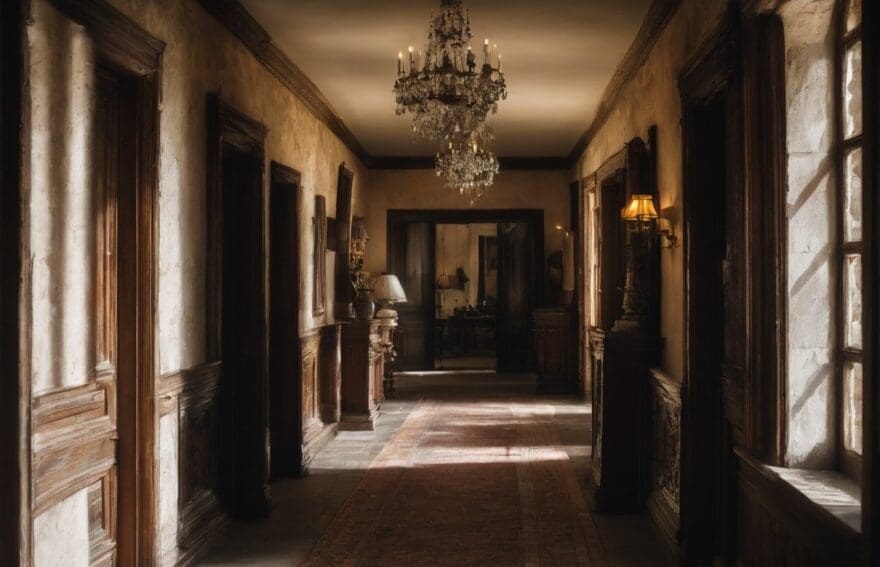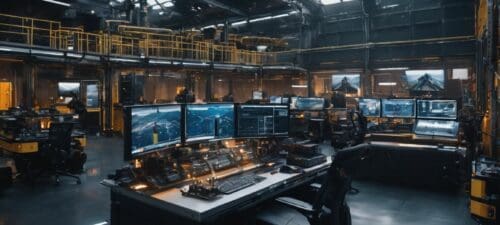Amnesia: The Dark Descent – A Decade of Darkness Revisited

Updated On: November 12, 2025 by 
Venturing into the sombre recesses of Brennenburg Castle, the chilling grip of “Amnesia: The Dark Descent” has certainly set many a heart racing. We’ve all crept gingerly along its dusky passageways, and with the game’s 10th anniversary upon us, it calls to mind just how pioneering it truly was.
Our article delves deep into this shadowy realm, shining a light on why this quintessential horror tale continues to unsettle and captivate in equal measure. Steel yourself – Amnesia retains its eerie prowess to thrill even after all these years.
The Haunting Horror of “Amnesia: The Dark Descent”
Immerse yourself in the dark and atmospheric gameplay of “Amnesia: The Dark Descent”, where psychological horror elements and a unique interactive experience await. Feel the sense of fear as you delve into the terrifying world of the game.
Dark and atmospheric gameplay
We step into the dimly lit corridors of Brennenburg Castle, and immediately the atmosphere tightens around us, thick with foreboding. Shadows play tricks on our eyes as we navigate through the labyrinthine halls, guiding Daniel on his harrowing quest.
The sense of isolation is palpable; every creaking door and distant scream heightens our own sense of dread.
The game’s design expertly crafts a mood that is both oppressive and captivating. As we explore deeper into the castle’s dark depths, each room presents a new challenge where survival hinges on quick thinking and stealth.
Our heart races with every flicker of candlelight—each corner turned could bring us face to face with unspeakable horrors. In this nightmare-inducing world, Amnesia: The Dark Descent holds us captive in its chilling embrace, leaving an indelible mark on the landscape of psychological horror games.
Psychological horror elements
The psychological horror elements in “Amnesia: The Dark Descent” immerse players in a terrifying atmosphere that distorts reality. Through the protagonist Daniel’s struggle to maintain sanity, players experience a chilling descent into madness.
Encounters with macabre visions and haunting memories evoke an intense feeling of dread, while the game’s use of darkness and isolation heightens the sense of vulnerability.
Monsters lurking in the shadows amplify the feeling of impending doom and helplessness. Players are constantly on edge, anticipating unpredictable horrors as they navigate through the eerie castle environment.
The game’s masterful manipulation of psychological terror leaves a lasting impression, making it a standout title in survival horror gaming.
Unique interactive experience
The psychological horror elements of “Amnesia: The Dark Descent” culminate in a unique interactive experience that immerses players into a nightmarish world. Players navigate the game’s environments through first-person perspective, feeling the tension and fear as they explore dark corners and uncover horrifying discoveries.
This allows for an immersive experience that enhances the sense of discovery and danger within the game, making it a nightmare-inducing journey.
Frictional Games has managed to create an atmospheric storytelling experience where players feel like they are truly part of the haunting narrative. Through exploration and discovery, players face a murderous antagonist from a first-person perspective, pushing them to survive with limited resources while maintaining their sanity.
The Evolution of Fear: Why is “Amnesia” Still Scary After 10 Years?
Amnesia: The Dark Descent continues to terrify players a decade after its release, thanks to its immersive and unpredictable gameplay, intense sound design, and masterful use of lighting and shadows.
These elements combine to create an atmosphere of fear that keeps players on the edge of their seats throughout the entire game.
Immersive and unpredictable gameplay
Immersive and unpredictable gameplay engrosses players in a terrifying first-person perspective. The game plunges them into a nightmare-inducing world where every corner holds the potential for terror.
Utilising innovative level design, the experience mirrors protagonist Daniel’s mental state, leaving players disoriented and on edge throughout their journey.
Monsters lurk around every turn, keeping players on their toes and heightening the sense of fear and vulnerability. With its labyrinth-like structure, Amnesia: The Dark Descent ensures a neverending sense of foreboding as gamers navigate through an environment that constantly keeps them guessing.
Intense sound design and music
The intense sound design and music in “Amnesia: The Dark Descent” play a crucial role in immersing players in its nightmarish world. From the haunting echoes of unseen horrors to the spine-chilling crescendos that accompany terrifying encounters, the game’s audio components heighten the sense of dread and unease.
The use of realistic environmental sounds, such as creaking doors and distant moans, adds to the overall atmosphere, making every step through Brennenburg Castle an anxiety-inducing experience.
In addition to sound effects, the game’s musical score is meticulously crafted to evoke feelings of fear and suspense. Eerie melodies and dissonant tones intensify during moments of danger, amplifying the player’s emotional response.
These elements blend seamlessly with gameplay, contributing significantly to the overall nightmare-inducing effect that “Amnesia: The Dark Descent” expertly delivers.
Masterful use of lighting and shadows
The game’s masterful use of lighting and shadows creates a chilling atmosphere, intensifying the feeling of dread and unease as players navigate through the dark corridors and eerie rooms.
The interplay between light and shadow heightens the sense of vulnerability, making every encounter with monsters or unknown threats all the more terrifying. The deliberate placement of light sources casts haunting silhouettes and ominous shapes, enhancing the psychological impact on players.
Amnesia: The Dark Descent’s strategic utilisation of lighting and shadows immerses players in an exceptionally sinister environment, amplifying the fear factor while traversing through menacing landscapes.
Lovecraftian Influence: A Perfect Marriage of Horror
Dive into the Lovecraftian themes and atmosphere that make “Amnesia: The Dark Descent” a perfect marriage of horror, from its inspired by classic horror literature to its impact on the horror gaming genre.
Want to explore more about the terrifying world of Amnesia? Keep reading!
Lovecraftian themes and atmosphere
The game’s eerie and unsettling atmosphere is heavily influenced by Lovecraftian themes, adding an extra layer of dread and enigma to the gameplay. The dark narrative, ancient otherworldly entities, and the sense of overwhelming insignificance in the face of cosmic horrors are all reminiscent of H.P.
Lovecraft’s work. This infusion of literary influence creates a deeply immersive experience that resonates with players on a profound level.
The inclusion of Lovecraftian elements elevates the horror in Amnesia: The Dark Descent beyond traditional scares and introduces a more existential fear that lingers long after playing.
The intertwining of psychological terror with otherworldly dread shapes an unforgettable gaming experience, setting it apart from standard horror games and solidifying its status as a landmark title in the genre.
Inspired by classic horror literature
Inspired by timeless horror literature, “Amnesia: The Dark Descent” weaves a narrative that draws from classic themes of fear and the unknown. The game pays homage to Lovecraftian influences, creating an atmospheric blend of psychological terror and supernatural dread.
Drawing from iconic works of horror fiction, it offers a gripping experience that resonates with those familiar with the genre while introducing newcomers to its chilling allure.
The game’s setting and storytelling reflect elements reminiscent of gothic novels and classic horror stories, immersing players in a world where every corner holds the potential for terror.
Impact on the horror gaming genre
Inspired by classic horror literature, “Amnesia: The Dark Descent” has left an indelible mark on the horror gaming genre. With its immersive first-person perspective, nightmare-inducing atmosphere, and innovative gameplay mechanics, the game redefined player expectations for survival horror games.
Its influence can be seen in subsequent titles that have embraced psychological terror, interactive storytelling, and atmospheric design to create an intense and heart-pounding experience for players.
The success of “Amnesia: The Dark Descent” has spurred a wave of first-person perspective, story-driven horror games that prioritise psychological unease over traditional jump scares.
Decade of Innovations: How “Amnesia” Pushed the Boundaries of Gaming
Amnesia: The Dark Descent pushed the boundaries of gaming by introducing revolutionary in-game physics, a groundbreaking use of the “sanity” meter, and influencing future horror games.
Its innovative gameplay mechanics set a new standard for immersive and unpredictable experiences in the horror genre.
Revolutionary in-game physics
Amnesia revolutionised horror gaming with its groundbreaking in-game physics, creating a deeply immersive experience for players. The realistic interaction with the game environment added an extra layer of tension and fear, making every move and action feel palpable and intense.
The physics engine elevated the sense of dread as objects responded realistically to the protagonist’s movements, enhancing the overall terror-inducing atmosphere.
This innovative approach to in-game physics set a new standard for horror games, influencing future titles in the genre. It brought a heightened level of realism and interactivity that intensified players’ sense of vulnerability and fear, cementing Amnesia’s status as a trailblazer in horror gaming.
Groundbreaking use of “sanity” meter
The game introduced a unique “sanity” meter, tracking the protagonist’s mental state. As players encountered terrifying situations and stayed in the darkness too long, Daniel’s sanity waned, distorting reality and making him more vulnerable to fear.
This innovative gameplay mechanic immersed players deeper into the psychological horror, blurring the lines between reality and hallucination. By cleverly integrating this feature into gameplay, Amnesia heightened tension and unease for an unforgettable gaming experience.
Notably, the “sanity” meter also influenced future horror games, inspiring developers to explore mental health as a core gameplay element. Its impact can be seen in subsequent titles as it continues to shape how games approach storytelling and player immersion in psychological horror experiences.
Influenced future horror games
The groundbreaking use of the “sanity” meter in Amnesia: The Dark Descent has had a lasting impact on future horror games. It introduced a new layer of psychological tension by directly tying the player’s mental state to the gameplay experience, influencing subsequent titles in the genre.
Game developers have since incorporated similar mechanics to immerse players further into terrifying and immersive narratives, creating a sense of vulnerability and fear that lingers long after the game is turned off.
This innovative approach brought about a shift in how horror games are designed, emphasising emotional and mental terror over traditional jump scares, shaping the future of horror gaming experiences for years to come.
Conclusion: The Legacy of “Amnesia: The Dark Descent”
Amnesia: The Dark Descent has left a lasting legacy in the horror gaming genre with its immersive gameplay and terrifying atmosphere. Its impact on future games and its cult following ensure that it will be remembered as a classic for years to come.
Cult following and continued popularity
Amnesia: The Dark Descent has garnered a devoted following over the past decade, with fans praising its relentless atmosphere and innovative gameplay. Its nightmarish world, coupled with the gripping storyline and psychological horror elements, continues to captivate gamers of all levels.
Additionally, this first-person nightmare-inducing game offers an experience unlike any other in the horror gaming genre, ensuring that it remains a timeless classic.
The continued popularity of Amnesia: The Dark Descent is evident in its remastered version and upcoming sequel. With its immersive, Lovecraftian-inspired world and groundbreaking features such as in-game physics and the “sanity” meter, this video game has not only influenced future horror games but also left an indelible mark on the history of gaming.
Remastered version and upcoming sequel
Frictional Games, the developers of Amnesia: The Dark Descent, released a remastered version of the game that captivated both existing fans and new players with its enhanced graphics and improved gameplay.
The updated edition allowed gamers to once again delve into the eerie depths of Brennenburg Castle with even more immersive detail and spine-chilling horror. Moreover, in 2020, Frictional Games unveiled “Amnesia: Rebirth,” a highly anticipated sequel that promised to continue the legacy of fear established by its predecessor while introducing a brand-new nightmare-inducing narrative.
The remastered version brought modern visuals to the classic horror title without compromising its original atmosphere or tension, providing an opportunity for both nostalgia and fresh scares.
Meanwhile, “Amnesia: Rebirth” teased an entirely new first-person perspective experience filled with psychological terror amidst otherworldly environments and sinister entities. This continuation aimed to further solidify Amnesia’s position as a cornerstone in horror gaming history, reinforcing the game’s influence on future titles within the genre.
Forever remembered as a classic in horror gaming.
Amnesia: The Dark Descent remains a standout in the horror gaming genre, captivating players with its spine-chilling atmosphere and immersive gameplay. Its influence is undeniable, as it continues to be celebrated for revolutionising first-person horror experiences.
With Lovecraftian themes, innovative in-game physics, and groundbreaking use of the “sanity” meter, Amnesia set a new standard for psychological terror in video games.
The game’s impact reaches far beyond its release, inspiring a cult following and leaving an indelible mark on future horror titles. Its enduring popularity speaks volumes about its lasting legacy as a truly iconic piece of interactive artistry that has permanently etched itself into gaming history.
FAQs
1. What is Amnesia: The Dark Descent?
Amnesia: The Dark Descent is a first-person horror game that takes players on a nightmare-inducing journey through dark and eerie environments.
2. How does the first-person perspective affect the game?
The first-person perspective in Amnesia: The Dark Descent makes the experience more immersive, letting you feel like you’re actually walking through the spooky corridors yourself.
3. Can I see what the game looks like before playing?
Yes, you can watch a trailer to get a glimpse of what awaits you in this chilling adventure from a decade ago.
4. Is Amnesia still scary to play after all these years?
Absolutely! Even after ten years, Amnesia: The Dark Descent remains as frightening as ever with its tense atmosphere and frightful encounters.









